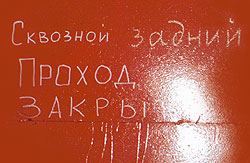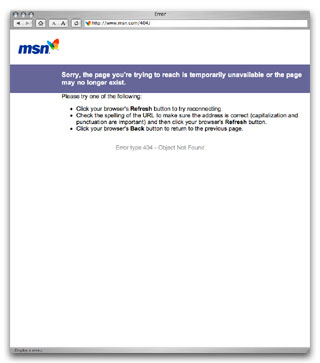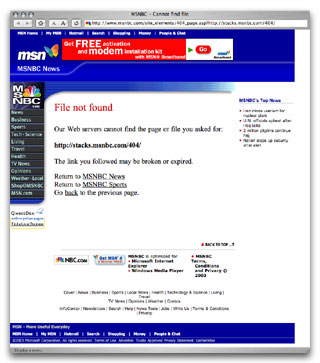|
Artemy Lebedev
§ 93. Fixing errors. URL errare humanum estJuly 5, 2002 |
|
Sometimes you are given the wrong address: looking for the apartment 58 in a house and can’t find it. There are two plausible scenarios you are going through: either it never existed, or it’s the wrong house that you’ve rambled into. The same with the WEB: a page or a file you have been looking for may not be there. |
 |
|
The internet is getting bigger, constantly in overhaul. Many pages that worked a year ago are no longer operational. It becomes apparent when you click some directory links. There’s nothing bad about it (a telephone number isn’t a lifetime property of the same subscriber). First, a page might have been intentionally made to last for a short time. Second, it might have been taken off as it’s no longer needed. Third, it might have moved to another address. In all these cases you should expect to see in the browser window a message that the page is not found, and the chances of retrieving it are slim. |
|
Every time you click a link or type the address manually, you browser sends an inquiry to the server. They say hello, and the browser inquires how it’s going. The server responds it’s going fine, get ya things outa here. Or wants to hear the magic word first. Or, on the contrary, reports that it’s not going to let the browser get it. |
|
To save time, the server gives its answers every time in the form of a number. These numbers are called status codes. There are five groups of these codes that differ in the first figure:
|
|
The second and third figures (xx) stand for the sequence number of the code. Suppose when you made an inquiry for the page of this section, your browser first got the code 200 from the server and then began to collect the document itself. In the fourth group 401 means the server requires user authentication (entering login and password). The code 402 means that to access the file, payment is required, but this code is not in use yet. The code 403 reports that access is forbidden. The code 404 stands for “not found”. |
HTTP 0.9 Status Codes (a document for historians) HTTP 1.1 Status Codes (final version) |
|
The status codes were approved in 1992 as part of the HTTP 0.9 protocol specification by the World Wide Web Consortium (W3C). They were invented by the same guy who invented the WEB, the first browser and HTML—Tim Berners-Lee. The system of access codes used in FTP since the early1980s served as a basis. |
Tim Berners-Lee home page
Official Specification of FTP |
|
Now that we know that 404 wasn’t a number picked from the random list, we can proceed to the questions of cashing in on the situation when a document search fails. |
|
In website organization, it is utterly commendable not only to make the main page coherent, but also to help the user understand where he or she is. We are interested in a particular case, when the user requests a document that the website for some reason doesn’t have. This situation is possible if the user typed in the address manually and made an error, or clicked a link to the address that is void. |
|
As a result, the following words appear on screen:
404 Not Found |
|
It would be unwise to let this chance slip away by not giving a hand to the lost user. Instead of this message many website builders place advertising, a slew of alluring images and tons of other information that overwhelms the user before he can say “boo”. That’s too bad. |
|
Given that the page’s volume in kilobytes will decide how fast it will download, you’d best avoid placing the following stuff on the 404 page:
|
|
Additionally, the non-existent page should not be allowed to be confused with a usual one. Therefore, the error page should not feature:
|
|
The sooner the user figures out that he’s strayed away from the intended path, the better. |
|
One should start with the page heading. Before anything actually downloads, the heading alone reading “page not found” will tell you a lot about an error in the address. If the user entered the address manually and made an error, he will immediately press the “Stop” button and correct the address. If he got to the error page by following a wrong link, he may wait until the 404 page download is complete and take appropriate actions. |
|
To help out the user, the error page should feature brief information making it clear that:
|
|
The latter message should also contain an option for advanced users to report the error to a website administrator. Additionally, the page must have links to the site map (if there is one) and the search engine (if there is one). |
|
The 404 page should employ all available visual means to get across a message that it’s not part of the website, but a dead-end. The message in the heading, another background color, no graphics, a black-and-white logo instead of the one in color, quick tips on what to do next—this is what an ideal 404 page looks like—a page that will help the user find what he’s been looking for at the website as quickly as possible. |
|
With presentation websites, you often have the opportunity to depart a little from the drab informational style. For instance, at the 404 page of the Russian car maker IZh-Auto website the logo is displayed as viewed from the back, coupled with a picture taken in one of the factory workshops: |
 |
http://www.izh-avto.com/404 |
|
The 404 page of MSN.com is all right, and that of MSNBC.com is a fright: |
|
By the way, Peugeot 404 (produced in 1957) once served as an illustration for the error page of the Peugeot international website. |
 |
|
Finally, there’s a rule of prime importance that a website builder must observe—the error address in the address line (excuse the tautology) should be kept in place. When the server leads the user to a special page with its own address (something like www.***.com/error/), don’t forget to sound off to let the administrator know what he’s worth. When the user misspells the address and can’t wait to get it right, you should instantly give him the chance to do that (to save him the trouble of retyping the address). |
|
If you wonder whether there’s the 404 page on a website, try our special tool. Type in the address of a website and press Enter: |
|
|
Examples of searches: http://www.cowparade.ru http://www.design.com http://www.knorr.ru |
|
|
|

